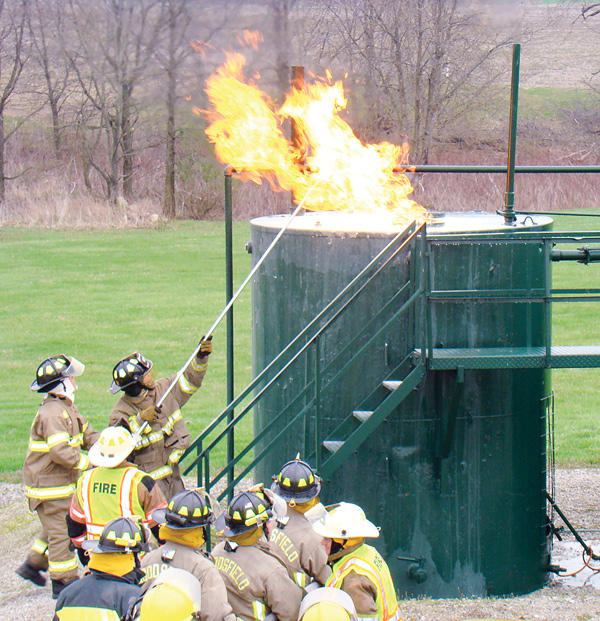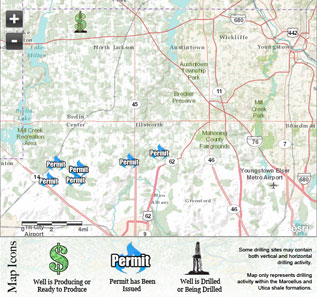Useful Links
Documents
- Injection Well AWMS Orders
- KDA Affidavit
- US vs. Ben Lupo - Indictment
- US vs. Ben Lupo - Criminal Complaint
- Final Analytical Report for Ohio EPA-NEDO
- D&L Sample Results Statement
- OhioEPA IPIR
- OhioEPA Notice of Violation
- Patriot vs. Ohio EPA Decision
- EPA Response - Patriot Water
- Patriot vs. Ohio EPA Motion to Dismiss
- ALOV Trumbull Group Lease

« Shale Sheet Home
Ohio at forefront of training for oil & gas emergencies

Through the Ohio Oil and Gas Energy Education Program, firefighters get hands-on training to handle just about any type of oil or gas emergency.
RELATED: New methods develop from past accidents
By ANNA TULTZ
TheNewsOutlet.org
Susan Allison of Dungannon still remembers the night in 2011 when she had to evacuate her home because of a gas explosion a half mile away.
“I heard a bang and what sounded like a plane, and it sounded like it kept getting closer and closer with bright lights, and I thought I was going to get hit with an airplane.”
The flames from that gas-pipeline explosion in Columbiana County could be seen as far away as Youngstown.
“It’s always on the back of your mind that it could still happen again,” said Allison.
There is good news for Allison and other Ohio residents who live near gas drilling and pipelines. Although a new player in the field of fracking, Ohio is at the forefront when it comes to training for gas and oil-field emergencies. In fact, first responders from veteran oil- and gas-producing states, such as Texas and Oklahoma, have come to the Buckeye State for emergency training.
“We’ve had fire departments from seven other states,” said Rhonda Reda, executive director of the Ohio Oil and Gas Energy Education Program.
Dallas Terrell, a Wooster firefighter and paramedic, went through the program.
“You get hands-on experience with what you’ll be dealing with when going out on a call. The props that are at the training facility are tremendous props. They actually light them on fire and practice how to control the situation, just exactly as would [happen] in the field.”
Reda, who has worked for several oil and gas companies, started the nonprofit OOGEEP group in 1998 when she saw first responders use water to douse a fire at a tank battery, a group of storage tanks that store oil. As a result, the water overflowed a containment dike and oil got into a nearby stream.
More than 600 of Ohio’s oil and gas producers voluntarily fund OOGEEP to provide responders training free of charge. The industry pays 5 cents per barrel of crude oil and 1 cent for every 1,000 cubic feet of natural gas.
Texas also provides its responders with free training, but it is not specific to gas and oil emergencies. Those are considered hazardous-materials emergencies, for which firefighters get additional training, said Glen Hogue of the Odessa Fire Rescue EMS division in Odessa, Texas.
“We’re required by the Texas commission to have 20 hours of continuing education and have to have an additional 10 hours of training in hazmat operations.”
In its 15-year existence, OOGEEP has trained more than 750 emergency responders from Ohio and elsewhere. The two-day training program is endorsed by the Ohio Fire Chiefs’ Association, Ohio Society of Fire Service Instructors and the Ohio Fire and Emergency Services Foundation.
Dora Silvis calls this a proactive approach by the gas and oil industry. Silvis is the executive vice president and chief operating officer of Alliance Petroleum Corp., which has oil wells across eastern Ohio.
“We live and work in our community, and we believe our community is important,” Silvis said.
Without a connection between the industry and the community, first responders could run into problems such as not knowing the locations of gas and oil fields or not knowing how to contact the company.
“We have contact with the gas companies that drill the wells,” said Andy Frost, chief of the Austintown Township Fire Department.
Frost said companies periodically come and provide training as well.
“A rep will come out and give a rundown on how the wells run and what’s going on with them,” he said.
Even larger companies, such as Chesapeake Energy, are keeping communication lines open. Willie Brantingham, Winona fire chief, said his department has had a positive experience with Chesapeake.
“When they first came in the area, they didn’t know the protocol,” said Brantingham, “but since then, they’ve been very cooperative with working with local departments and letting them know they’re in the area.”
Having that open communication is important when there is an emergency. Unlike routine calls, firefighters must take a more cautious approach to gas and oil emergencies.
“As long as it doesn’t pose as a fire risk, we wait for the gas company to get there,” Frost said.
The job of responders when they get to a gas emergency is to keep the situation contained and assist the gas company.
“It’s very typical that we’re just there to protect the perimeter and making sure nothing gets outside the area,” Brantingham said.
The oil and gas companies also have a list of 24-hour emergency service numbers. For example, Alliance Petroleum, which has a 24-hour answering service, also has a list of people to contact, but also a guide on what needs to be done during an emergency.
“Should something happen, our field employee, who is responsible for the site, would be there with the first responders,” Silvis said.
Local first responders don’t really need more equipment. Typically, the foam that is used can be found on most firetrucks.
“The equipment needed is not much different than on normal firetrucks,” said Frost.
There are instances when additional help and equipment is needed, but according to Mark Del Protost, Wooster Township fire chief, these don’t happen often.
“[We] can have incidents when wells are being drilled and may need services of drilling companies or specialty firefighting teams, but they are extremely, extremely rare,” Del Protost said.
Meanwhile, OOGEEP continues its training efforts and now is helping Pennsylvania start its own training program.
“The industry could not keep pace in demand for the training and came to me,” said Ed Mann, Pennsylvania state fire commissioner. “I said, ‘We’ll do it, but you have to pay for it.’ They said, ‘No problem.’”
In 2011, Pennsylvania received grants from the Marcellus Shale Coalition and the Pennsylvania Independent Oil and Gas Association to develop the training program. Also, in 2012, Pennsylvania imposed an impact fee, based on the number of drilled wells, to continue funding the program.
“Pennsylvania is eight months out from starting its training program,” said Reda.
TheNewsOutlet.org is a collaborative effort among the Youngstown State University journalism program, Kent State University, The University of Akron and professional media outlets including WYSU-FM Radio and The Vindicator (Youngstown), The Beacon Journal and Rubber City Radio (Akron).
















Subscribe Today
Sign up for our email newsletter to receive daily news.
Want more? Click here to subscribe to either the Print or Digital Editions.